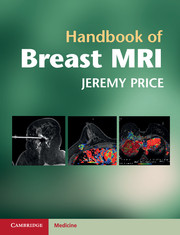Book contents
- Frontmatter
- Contents
- Preface
- Acknowledgements
- Glossary
- Abbreviations
- 1 Basics of breast MRI
- 2 Imaging-related anatomy and pathology
- 3 Interpreting breast MRI studies
- 4 MRI-guided biopsy techniques
- 5 High-risk screening using breast MRI
- 6 Preoperative staging with breast MRI
- 7 Problem-solving applications of breast MRI
- 8 MRI after breast augmentation
- Answers to multiple choice questions
- Appendices
- Index
- Plate section
- References
8 - MRI after breast augmentation
Published online by Cambridge University Press: 05 March 2012
- Frontmatter
- Contents
- Preface
- Acknowledgements
- Glossary
- Abbreviations
- 1 Basics of breast MRI
- 2 Imaging-related anatomy and pathology
- 3 Interpreting breast MRI studies
- 4 MRI-guided biopsy techniques
- 5 High-risk screening using breast MRI
- 6 Preoperative staging with breast MRI
- 7 Problem-solving applications of breast MRI
- 8 MRI after breast augmentation
- Answers to multiple choice questions
- Appendices
- Index
- Plate section
- References
Summary
Chapter outline
Historical background
Implant types and terminology
Fibrous capsule formation and contracture
The evolution of silicone implants
Normal MRI features of silicone implants
MRI appearances of implant complications
Cancer incidence and detection in women with implants
Tissue breast reconstructive surgery
Augmentation by direct injection procedures
Historical background
Over the last hundred or so years, attempts at breast augmentation have been documented using an astonishing variety of materials including ivory, glass beads, ground rubber, gutta percha and ox cartilage [1]. The range of injectable substances used includes paraffin oil, petroleum jelly, glazier’s putty, beeswax, shellac and epoxy resin [1]. Not surprisingly, complications were frequent, often relating to foreign body reactions with tissue necrosis, fistula formation and infection. With the advent of synthetic polymers, new concepts were trialled in the form of polythene chips, polythene tape or strips wound into a ball-shape, polymer sponges, Terylene wool, silastic rubber and polypropylene string, but none of these materials gave a particularly natural cosmetic effect.
- Type
- Chapter
- Information
- Handbook of Breast MRI , pp. 172 - 188Publisher: Cambridge University PressPrint publication year: 2011



